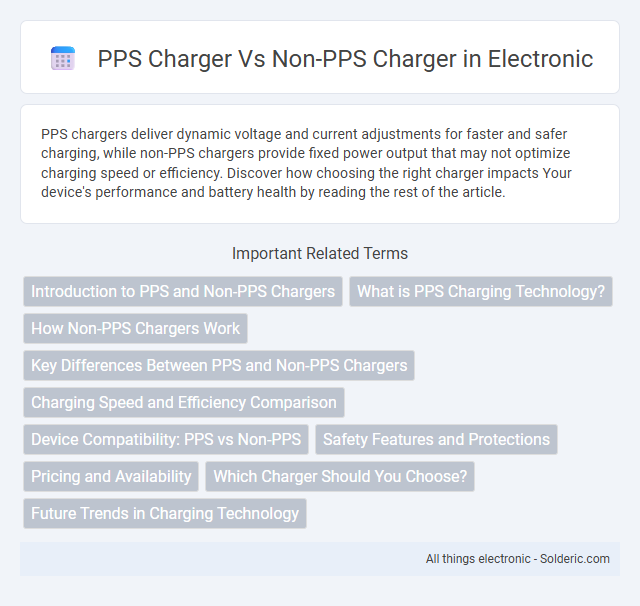PPS chargers deliver dynamic voltage and current adjustments for faster and safer charging, while non-PPS chargers provide fixed power output that may not optimize charging speed or efficiency. Discover how choosing the right charger impacts Your device's performance and battery health by reading the rest of the article.
Comparison Table
| Feature | PPS Charger | Non-PPS Charger |
|---|---|---|
| Full Name | Programmable Power Supply (PPS) | Standard USB Power Delivery or Quick Charge |
| Voltage Regulation | Dynamic voltage adjustment in 20mV steps | Fixed voltage levels (e.g., 5V, 9V, 12V) |
| Current Regulation | Adaptive current control | Fixed current limits per profile |
| Charging Efficiency | Higher efficiency, reduces heat generation | Moderate efficiency, more heat produced |
| Device Compatibility | Supports newer devices with PPS protocol (e.g., Samsung, OnePlus) | Supports broader range of older devices |
| Charging Speed | Faster, optimized charging speeds | Standard fast charging speeds |
| Safety | Enhanced safety with fine voltage adjustment | Basic safety with predefined voltage steps |
| Standardization | Defined in USB Power Delivery 3.0 PPS extension | USB Power Delivery 2.0/3.0 or proprietary QC standards |
Introduction to PPS and Non-PPS Chargers
PPS (Programmable Power Supply) chargers offer dynamic voltage and current adjustments, optimizing charging efficiency and reducing battery stress compared to non-PPS chargers that provide fixed output levels. Your devices benefit from faster and safer charging cycles with PPS technology, which adapts power delivery based on real-time battery conditions. Non-PPS chargers lack this adaptability, often resulting in slower charging speeds and potential heat generation during the process.
What is PPS Charging Technology?
PPS (Programmable Power Supply) charging technology dynamically adjusts voltage and current to optimize charging speed and improve battery health. This advanced method enables your device to receive a tailored power output, reducing heat generation and enhancing overall efficiency compared to non-PPS chargers. Using a PPS charger ensures faster, safer charging by adapting in real time to your device's power requirements.
How Non-PPS Chargers Work
Non-PPS chargers operate using fixed voltage levels, delivering consistent power without adjusting to the device's dynamic charging needs, which can lead to less efficient energy transfer and increased heat generation. Unlike PPS chargers that utilize programmable voltage and current adjustments based on real-time communication with your device, Non-PPS chargers rely on standard USB Power Delivery profiles, limiting their adaptability. This means your device may charge slower or experience more power loss during charging cycles with a Non-PPS charger compared to a PPS-enabled one.
Key Differences Between PPS and Non-PPS Chargers
PPS chargers offer dynamic voltage and current adjustment, allowing for more efficient and safer fast charging by tailoring power delivery to your device's real-time needs. Non-PPS chargers provide fixed voltage levels, which can result in slower charging speeds and less optimized power management. Your device benefits from enhanced battery longevity and reduced heat generation when using PPS chargers compared to non-PPS options.
Charging Speed and Efficiency Comparison
PPS chargers deliver variable voltage and current tailored to the device's real-time power requirements, significantly enhancing charging speed and energy efficiency compared to non-PPS chargers that provide fixed outputs. This dynamic adjustment reduces heat generation and energy loss, allowing devices to reach full charge faster while maintaining battery health. Non-PPS chargers often result in slower charging and higher energy waste due to their inability to adapt to the battery's optimal charging parameters.
Device Compatibility: PPS vs Non-PPS
PPS chargers provide enhanced device compatibility by dynamically adjusting voltage and current based on the connected device's requirements, ensuring more efficient and safer charging for a wide range of smartphones and laptops supporting USB Power Delivery 3.0 standards. Non-PPS chargers offer fixed voltage levels, which may limit compatibility and reduce charging efficiency with modern devices that demand precise power delivery protocols. Your device benefits from PPS chargers by receiving optimized power delivery, reducing heat generation and extending battery lifespan.
Safety Features and Protections
PPS chargers incorporate dynamic voltage and current adjustments, reducing the risk of overheating and electrical damage by tailoring power delivery to your device's needs. Non-PPS chargers typically offer fixed power outputs, which may increase the likelihood of overheating, short circuits, or battery degradation over time. Your safety benefits from the advanced protection protocols in PPS chargers, including overvoltage, overcurrent, and temperature control mechanisms that ensure reliable and secure charging.
Pricing and Availability
PPS chargers generally have a higher price point due to their advanced power delivery technology, which allows for more precise voltage and current adjustments, enhancing device safety and charging efficiency. Non-PPS chargers are often more affordable and widely available in retail stores, making them accessible for everyday use but lacking the adaptive charging features found in PPS models. The growing demand for fast and safe charging is increasing the availability of PPS chargers, especially in online marketplaces and specialized tech retailers.
Which Charger Should You Choose?
Choosing a PPS charger over a non-PPS charger ensures faster and more efficient charging by dynamically adjusting voltage and current to your device's needs, reducing heat and preserving battery health. Non-PPS chargers provide fixed output levels, which may not optimize charging speed or protect your battery as effectively. Your best choice depends on device compatibility and charging speed preferences, with PPS offering a significant advantage for supported smartphones and laptops.
Future Trends in Charging Technology
PPS chargers utilize Programmable Power Supply technology, enabling dynamic voltage and current adjustments for faster, more efficient charging that reduces heat and prolongs battery life. Non-PPS chargers follow fixed voltage protocols, limiting adaptability to newer smart devices and optimized charging profiles. As future trends emphasize intelligent energy management and device compatibility, PPS technology is poised to become the standard in smart charging solutions, ensuring your devices charge quicker and safer.
PPS charger vs Non-PPS charger Infographic

 solderic.com
solderic.com